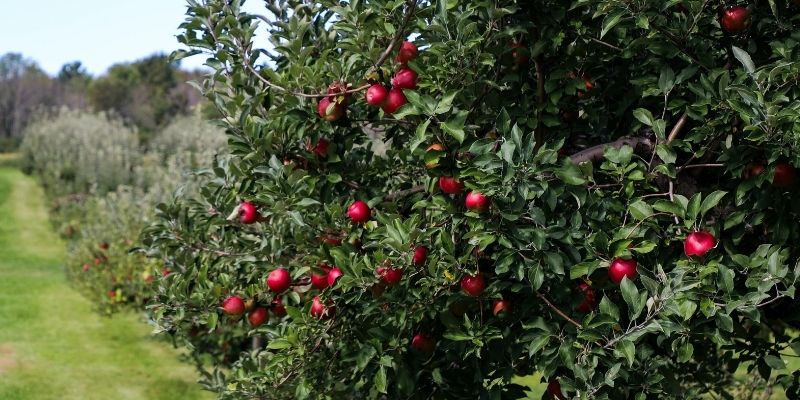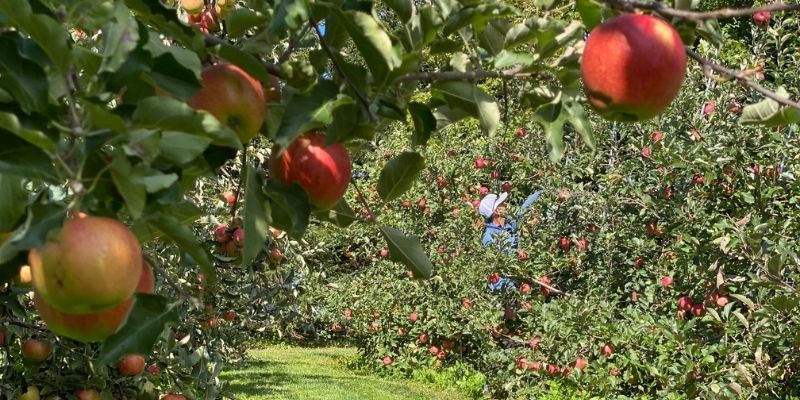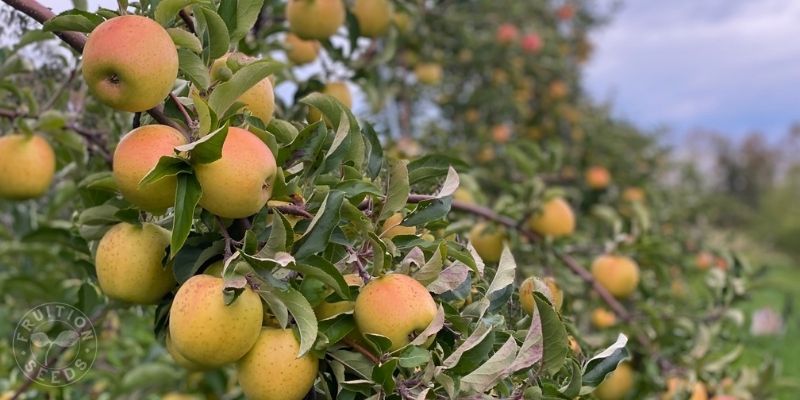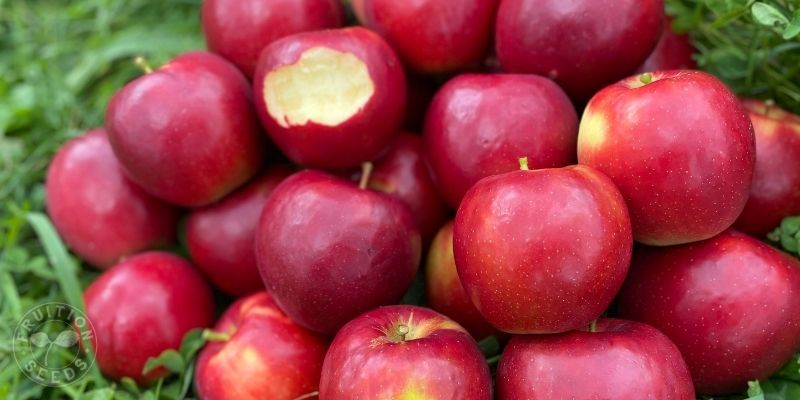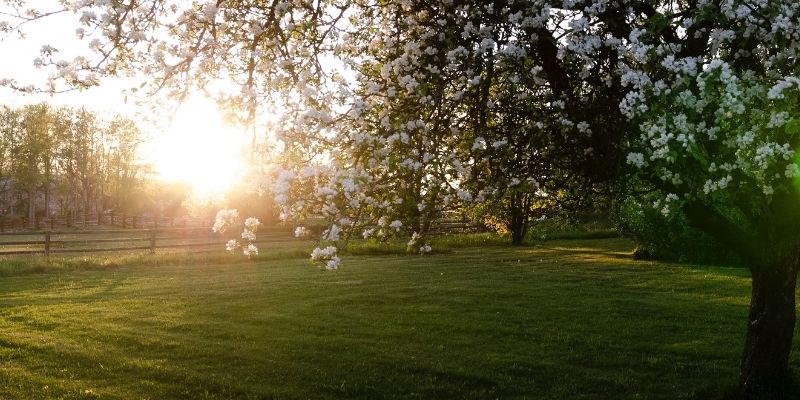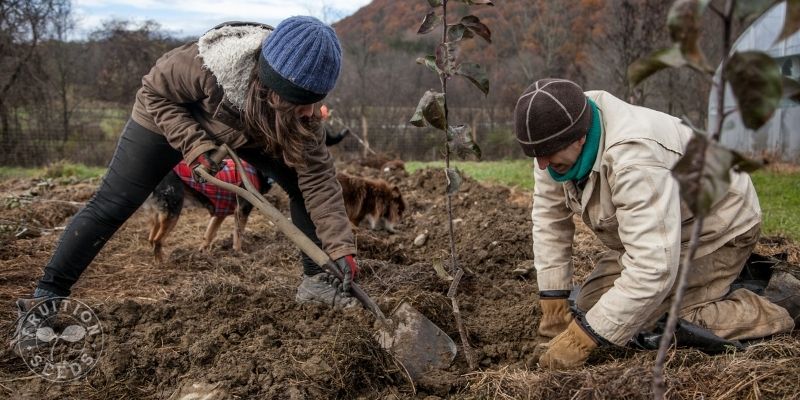Friends, we want to be sure that the trees we share with you will surround you with abundance. Also, we have limited experience growing apples in climates different from our own. Some varieties do better in the north and others do better in the south.
We are so grateful for our many apple mentors for sharing their joy, experience and curiosity with us — find and connect with the apple community in your area, they’re looking for you, too!
In the meantime, if you live in a state that isn’t included in our shipping range and have feedback for us, please let us know! We’d love to hear your experience and may expand our shipping range in future years as we gain more knowledge about growing apples beyond our region.
The phenomena of winter hardiness and ‘chill hour requirements’ also play a role in our decision to limit the areas we ship to. Let’s dive in ~
Hardiness zones
Though apples grow from Alaska to Guatemala, not all varieties have the same tolerance to frigid winters. By knowing the cold hardiness zone that we live in, we can choose varieties that will endure our coldest winter temperatures. The zones in the USDA’s cold hardiness map are an average based on the lowest temperatures that an area will reach over a 30 year average. All of Fruition’s trees are hardy to zone 4!
Also, due to climate change, these zones are shifting for the warmer. About 20 years ago we were considered zone 4 in western New York and now it is zone 5, with temperatures only falling to -20F at the lowest, rather than -25F as was recorded historically. By being in zone 4, it means that varieties hardy to zone 3 will be plenty hardy for our area. If we are planting a tree only hardy to zone 5 then we might need to trial it before assuming it will be hardy.
Rootstock also plays a role in hardiness and needs careful consideration as well. Some rootstocks go dormant more quickly than others, making them more winter hardy. Most of the Geneva rootstocks are considered very hardy to zone 4. Semi-dwarf Geneva 935 is hardy to zone 3 and can be grown everywhere except the coldest areas. When temperatures begin to drop and trees begin hardening off, they first go dormant at their branch tips and then proceed to harden off down through the branches and the center of the tree. The rootstock above the soil line is often the last place to harden off before deep winter sets in and if it doesn’t quite get there, it will sustain winter injury or even worse, not make it.
Chill Hours
Areas in warmer locations need to assess if they will have enough ‘chill hours’ to meet the requirement of a particular variety. Chill hours, also called ‘chill units’ are the number of hours a fruit tree spends between above freezing and lower than 45 degrees F, 7 degrees C, before it begins to break out of dormancy.
There are over 8,000 apple varieties worldwide, from all different climates of the world. Those that have parentage from colder areas tend to have more chill hour requirements, which is what keeps trees from breaking dormancy when it’s still too cold. All those raw chilly hours in spring are very important to trees and woody plants of all kinds.
Apples for southern locations are adapted to short mild springs where they wake up fairly quickly from dormancy, without threat of ongoing freezing temperatures. There is far less risk of flowers getting nipped by frosts in April and the seasons don’t stay cold for very long. Apple trees in the south essentially wake up quicker than those in the north. Our cold hardy northern apple varieties require a high amount of chill units to keep them dormant through the freeze thaw cycles of late winter and early spring. We think of it as mother nature’s way of tracking time until it is warm enough to start sending out tender buds. And thank goodness because if not, trees like apples could start leafing out during a warm spell in February! That being said, if we have an abnormally warm winter in the north, even northern varieties will eventually start breaking dormancy much earlier because they’ve accumulated their chill hours earlier than normal.
If a southern apple is to be planted in a northern zone 4 location, then there is the risk that it will break dormancy too early in the spring, when temperatures are still fluctuating between freezing and thawing. Once a tree breaks dormancy, it is no longer as hardy as it was while dormant. On the other hand, if a northern variety is planted in the south, it may not reach the amount of chilling requirements it needs which will affect the flowering. Bloom time may be delayed or not even happen at all, resulting in no fruit.
Most apple trees require somewhere in the range of 600-800 chilling hours to complete dormancy. Once the requirement is met, the hormones responsible for dormancy start breaking down. Apple growers in zone 7 and higher need to pay extra attention to sourcing trees that have low chill hour requirements. In places like southern California, orchardists look to varieties that need fewer than 300 chilling hours.
For the most part, in the north, we don’t need to be too concerned about chill hours if we’re sticking with planting cold hardy apple varieties which is why it isn’t listed or mentioned nearly as much as hardiness in many nursery catalogs. We can usually assume that cold hardy varieties will stay plenty dormant until it is time to wake up, unless of course there is a much milder winter than normal, leading them to accumulate their hours earlier than usual. In southern locations, it is vital to plant varieties with low chill hours. In northern areas, chill hours become more relevant when planting stone fruit like apricots which have low chill requirements leading them to break dormancy too early when it is still too cold.
Often nursery catalogs in southern areas will list the chill hour requirements near with the zone hardiness at the end of descriptions. The best way to get this info is through the local extension office or check out a map online.
There’s so much more to share, Friends!
Hop into our many blogs below and stay tuned for our upcoming webinars, on-farm events and a step-by-step course, Organic Apples & Orcharding!
5 Keys for Establishing an Organic Orchard + 5 Common Mistakes to Avoid
6 Core Questions for Orchard Planning
10 Steps for Planting an Apple Tree
Soil Testing for Trees & Orchards
Fruition’s current online tree growing resources are focused on Apple Trees (and it is also true that Pears, Plums, Peaches, Apricots and Cherries require much the same site choice, planting, and basic care considerations!) On that note, we hope you'll enjoy Fruition's free full library of Growing Trees Resources. Also recommended are all books by the late Michael Phillips and the online resources at the New England Tree Fruit Management Guide. In the meantime, enjoy more Fruition tree growing resources:
Apple Tree Growing Guide
Fruit Q&Qs pre-recorded Webinar Library
and join us for future live Fruit Q&Q webinars here!
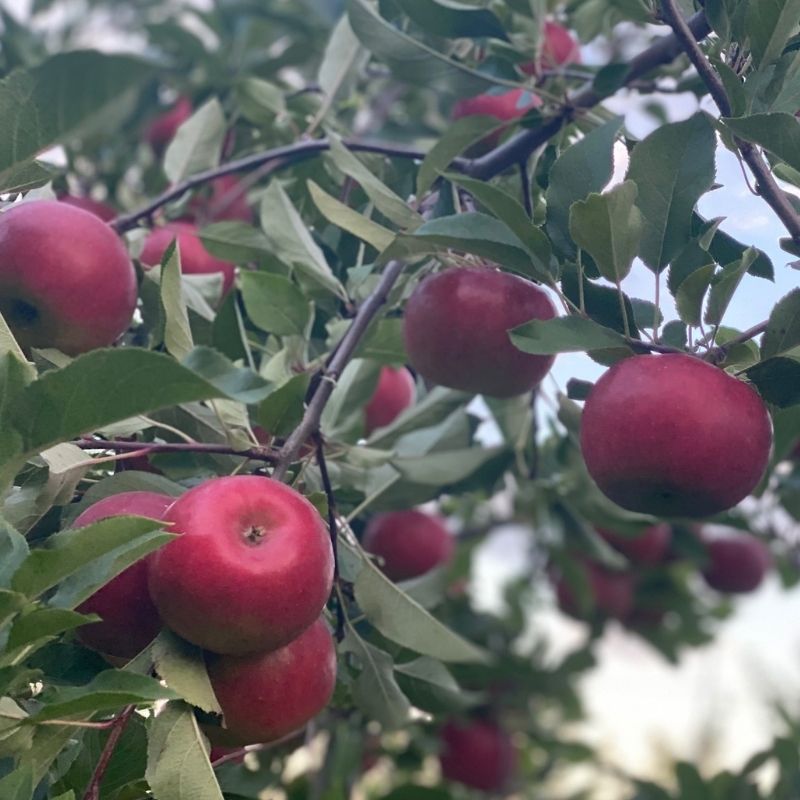
Be in the know:
Fruition's Fruit Tree Updates!
You'll receive seasonal tree insights & how-to's plus be the first to know about invitations to tree events on-farm and online!
Visit our newsletter website and subscribe to the 'Tree Updates' section
Enjoy our free online Apples & Organic Orcharding course and Tree Webinar Q&Qs Library in the meantime & don't be shy!
~When you join us, check your inbox for your welcome & access info! Stay tuned for our weekly organic gardening tips & inspiration, as well~
Sending love from our gardens to yours!
Sow Seeds & Sing Songs,

& the whole Fruition crew
